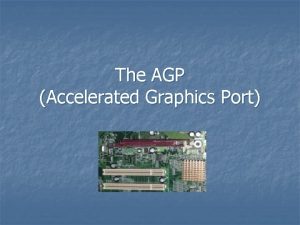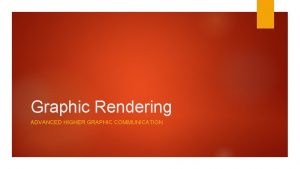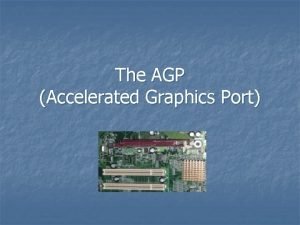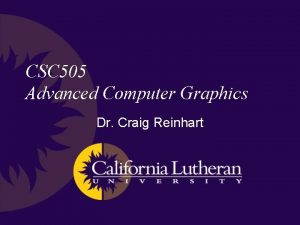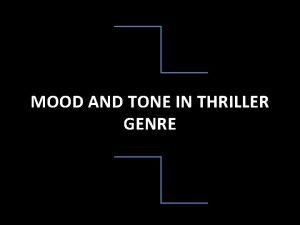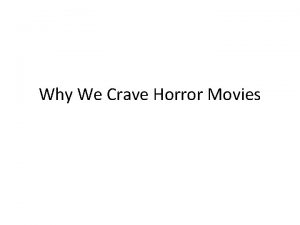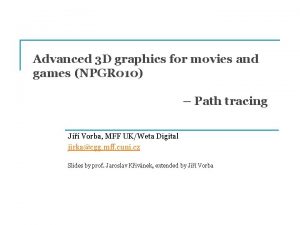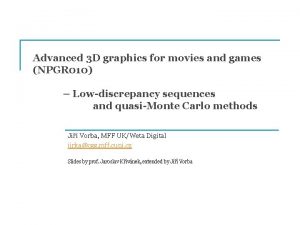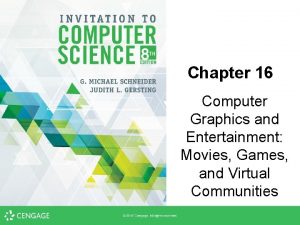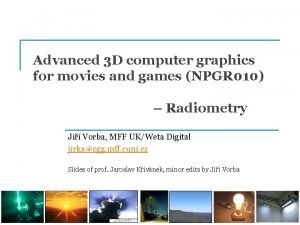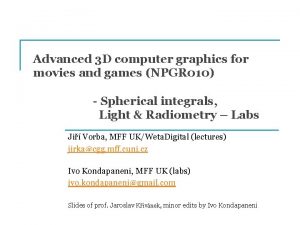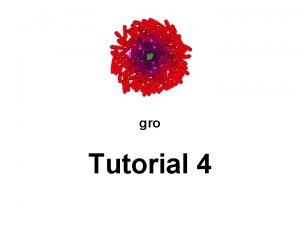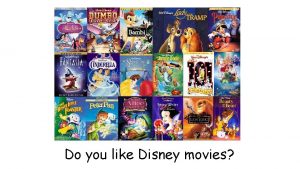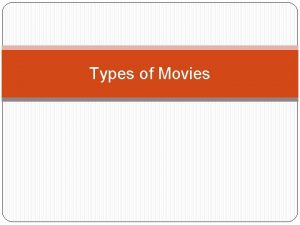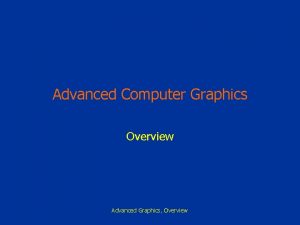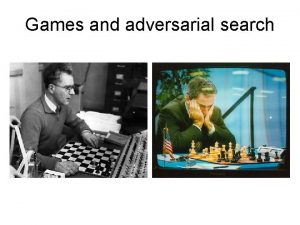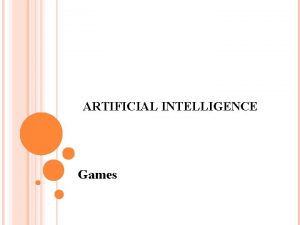Advanced 3 D graphics for movies and games









![Eric Veach [1997] n https: //www. youtube. com/watch? v=e 3 ss_Ozb 9 Yg Advanced Eric Veach [1997] n https: //www. youtube. com/watch? v=e 3 ss_Ozb 9 Yg Advanced](https://slidetodoc.com/presentation_image_h2/e29bcc8136b8c697b61efbb3d8f9accc/image-10.jpg)





![Balance heuristic n The balance heuristic is almost optimal [Veach 97] q n No Balance heuristic n The balance heuristic is almost optimal [Veach 97] q n No](https://slidetodoc.com/presentation_image_h2/e29bcc8136b8c697b61efbb3d8f9accc/image-16.jpg)


























- Slides: 42

Advanced 3 D graphics for movies and games (NPGR 010) – Multiple Importance Sampling Jiří Vorba, MFF UK/Weta Digital jirka@cgg. mff. cuni. cz Slides of prof. Jaroslav Křivánek, minor edits by Jiří Vorba

Sampling of environment lighting Advanced 3 D Graphics (NPGR 010) - J. Vorba 2020, created by J. Křivánek 2015

MIS 300 + 300 samples EM IS 600 samples BRDF IS 600 samples Sampling of environment lighting Diffuse only Ward BRDF, a=0. 2 Ward BRDF, a=0. 05 Ward BRDF, a=0. 01

Sampling of environment lighting n Two different sampling strategies for generating the incoming light direction win 1. BRDF-proportional sampling - pa(win) 2. Environment map-proportional sampling - pb(win) Advanced 3 D Graphics (NPGR 010) - J. Vorba 2020, created by J. Křivánek 2015

What is wrong with using either of the two strategies alone? f(x) pa(x) pb(x) xa Advanced 3 D Graphics (NPGR 010) - J. Vorba 2020, created by J. Křivánek 2015

Better strategy f(x) pa(x) pb(x) Advanced 3 D Graphics (NPGR 010) - J. Vorba 2020, created by J. Křivánek 2015

Example: Sum of two Gaussians f(x) pa(x) pb(x) Advanced 3 D Graphics (NPGR 010) - J. Vorba 2020, created by J. Křivánek 2015

Notes on the previous slides n n n We have a complex multimodal integrand g(x) that we want to numerically integrate using a MC method with importance sampling. Unfortunately, we do not have a PDF that would mimic the integrand in the entire domain. Instead, we can draw the sample from two different PDFs, pa and pb each of which is a good match for the integrand under different conditions – i. e. in different part of the domain. However, the estimators corresponding to these two PDFs have extremely high variance – shown on the slide. We can use Multiple Importance Sampling (MIS) to combine the sampling techniques corresponding to the two PDFs into a single, robust, combined technique. The MIS procedure is extremely simple: sample from both techniques pa and pb , and then weight the samples appropriately. This estimator is really powerful at suppressing outlier samples such as those that you would obtain by picking x_from the tail of pa, where g(x) might still be large. Without having pb at our disposal, the MC estimator would be dividing the large g(x) by the small pa (x), producing an outlier sample. The combined technique has a much higher chance of producing this particular x (because it can sample it also from pb), so the combined estimator divides g(x) by [pa (x) + pb(x)] / 2, which yields a much more reasonable sample value. I want to note that what I’m showing here is called the “balance heuristic” and is a part of a wider theory on weighted combinations of estimators proposed by Veach and Guibas. Advanced 3 D Graphics (NPGR 010) - J. Vorba 2020, created by J. Křivánek 2015

Multiple Importance Sampling
![Eric Veach 1997 n https www youtube comwatch ve 3 ssOzb 9 Yg Advanced Eric Veach [1997] n https: //www. youtube. com/watch? v=e 3 ss_Ozb 9 Yg Advanced](https://slidetodoc.com/presentation_image_h2/e29bcc8136b8c697b61efbb3d8f9accc/image-10.jpg)
Eric Veach [1997] n https: //www. youtube. com/watch? v=e 3 ss_Ozb 9 Yg Advanced 3 D Graphics (NPGR 010) - J. Vorba 2020, created by J. Křivánek 2015

Multiple Importance Sampling n n n Given n sampling techniques (i. e. pdfs) p 1(x), . . , pn(x) We take ni samples Xi, 1, . . , Xi, ni from each technique Combined estimator Combination weights (different for each sample) sampling techniques samples from individual techniques Advanced 3 D Graphics (NPGR 010) - J. Vorba 2020, created by J. Křivánek 2015

Unbiasedness of the combined estimator n The MIS estimator is unbiased… n … provided the weighting functions sum up to 1 Advanced 3 D Graphics (NPGR 010) - J. Vorba 2020, created by J. Křivánek 2015

Choice of the weighting functions n Objective: minimize the variance of the combined estimator 1. Arithmetic average (very bad combination) 2. Balance heuristic (very good combination) q …. Advanced 3 D Graphics (NPGR 010) - J. Vorba 2020, created by J. Křivánek 2015

Balance heuristic n Combination weights Advanced 3 D Graphics (NPGR 010) - J. Vorba 2020, created by J. Křivánek 2015

MIS estimator with the Balance heuristic n Plugging Balance heuristic weights into the MIS formula q q The contribution of a sample does not depend on which technique (pdf) it came from Effectively, the sample is drawn from a weighted average of the individual pdfs – as can be seen from the form of the estimator Advanced 3 D Graphics (NPGR 010) - J. Vorba 2020, created by J. Křivánek 2015
![Balance heuristic n The balance heuristic is almost optimal Veach 97 q n No Balance heuristic n The balance heuristic is almost optimal [Veach 97] q n No](https://slidetodoc.com/presentation_image_h2/e29bcc8136b8c697b61efbb3d8f9accc/image-16.jpg)
Balance heuristic n The balance heuristic is almost optimal [Veach 97] q n No other weighting has variance much lower than the balance heuristic Our work [Kondapaneni et al. 2018] revises MIS q If you allow negative weights, one can improve over the balance heuristic a lot Advanced 3 D Graphics (NPGR 010) - J. Vorba 2020, created by J. Křivánek 2015

MIS for direct illumination from enviro lights

Application of MIS to environment light sampling n n Recall: Two sampling strategies for generating the incident direction wi 1. BRDF-proportional sampling - pa(win) 2. Environment map-proportional sampling - pb(win) Plug formulas for pa(win) and pb(win) into the general MIS formulas above Advanced 3 D Graphics (NPGR 010) - J. Vorba 2020, created by J. Křivánek 2015

Direct illumination: Two strategies n Which strategy should we choose? q n Both strategies estimate the same quantity Lout(x, wout) q n Both! A mere sum would estimate 2 × Lout(x, wout) , which is wrong We need a weighted average of the techniques, but how to choose the weights? → MIS Advanced 3 D Graphics (NPGR 010) - J. Vorba 2020, created by J. Křivánek 2015

MIS weight calculation MIS weight for a sample direction generated by BRDF lobe sampling PDF for BRDF sampling n PDF with which the direction win, j would have been generated, if we used env map sampling Here, we assume one sample from each of the two strategies Advanced 3 D Graphics (NPGR 010) - J. Vorba 2020, created by J. Křivánek 2015

MIS for enviro sampling – Algorithm Vec 3 omega. In. A = generate. Brdf. Sample(); float pdf. A = eval. Brdf. Pdf(omega. In. A); float pdf. As. If. From. B = eval. Env. Map. Pdf(omega. In. A); float mis. Weight. A = pdf. A / (pdf. A + pdf. As. If. From. B); Rgb out. Radiance. Estimate = mis. Weight. A * inc. Radiance(omega. In. A) * brdf(omega. Out, omega. In. A) * max(0, dot(omega. In. A, surf. Normal) / pdf. A; Vec 3 omega. In. B = generate. Env. Map. Sample(); float pdf. B = eval. Env. Map. Pdf(omega. In. B); float pdf. As. If. From. A = eval. Brdf. Pdf(omega. In. B); float mis. Weight. B = pdf. B / (pdf. B + pdf. As. If. From. A); out. Radiance. Estimate += mis. Weight. B * inc. Radiance(omega. In. B) * brdf(omega. Out, omega. In. B) * max(0, dot(omega. In. B, surf. Normal) / pdf. B;

MIS 300 + 300 samples EM IS 600 samples BRDF IS 600 samples MIS applied to enviro sampling Diffuse only Ward BRDF, a=0. 2 Ward BRDF, a=0. 05 Ward BRDF, a=0. 01

MIS for direct illumination from area lights

Image: Alexander Wilkie Area light sampling – Motivation Sampling technique (pdf) pa: BRDF sampling Sampling technique (pdf) pb: Light source area sampling Advanced 3 D Graphics (NPGR 010) - J. Vorba 2020, created by J. Křivánek 2015

Recall: Irradiance estimate and G term n Reformulate the reflection integral (change of variables) n PDF for uniform sampling of the surface area: Advanced 3 D Graphics (NPGR 010) - J. Vorba 2020, created by J. Křivánek 2015 25

Image: Alexander Wilkie MIS-based combination Arithmetic average Preserves bad properties of both techniques MIS w/ the balance heuristic Bingo!!! Advanced 3 D Graphics (NPGR 010) - J. Vorba 2020, created by J. Křivánek 2015

Images: Eric Veach Area light sampling – Classic Veach’s example BRDF proportional sampling Light source area sampling Advanced 3 D Graphics (NPGR 010) - J. Vorba 2020, created by J. Křivánek 2015

MIS-based combination Multiple importance sampling & Balance heuristic (Veach & Guibas, 95) Image: Eric Veach n Advanced 3 D Graphics (NPGR 010) - J. Vorba 2020, created by J. Křivánek 2015

Direct illumination: Two strategies n BRDF proportional sampling q q n Better for large light sources and/or highly glossy BRDFs The probability of hitting a small light source is small -> high variance, noise Light source area sampling q q q Better for smaller light sources It is the only possible strategy for point sources For large sources, many samples are generated outside the BRDF lobe -> high variance, noise Advanced 3 D Graphics (NPGR 010) - J. Vorba 2020, created by J. Křivánek 2015

Example PDFs n BRDF sampling: pa(w) q n Depends on the BRDF, e. g. the formulas for physicallybased Phong BRDF from the last lecture Light source area sampling: pb(w) Conversion of the uniform pdf 1/|A| from the area measure (d. A) to the solid angle measure (dw) Advanced 3 D Graphics (NPGR 010) - J. Vorba 2020, created by J. Křivánek 2015

Image: Alexander Wilkie Contributions of the sampling techniques wa * BRDF sampling wb * light source area sampling Advanced 3 D Graphics (NPGR 010) - J. Vorba 2020, created by J. Křivánek 2015

Alternative MIS heuristics

Alternative combination heuristics n n “Low variance problems” Whenever one sampling technique yields a very low variance estimator, balance heuristic can be suboptimal Advanced 3 D Graphics (NPGR 010) - J. Vorba 2020, created by J. Křivánek 2015

Alternative combination heuristics n n n “Low variance problems” Whenever one sampling technique yields a very low variance estimator, balance heuristic can be suboptimal “Power heuristic” or other heuristics can be better in such a case – see next slide Advanced 3 D Graphics (NPGR 010) - J. Vorba 2020, created by J. Křivánek 2015

Advanced 3 D Graphics (NPGR 010) - J. Vorba 2020, created by J. Křivánek 2015

Other examples of MIS applications In the following we apply MIS to combine full path sampling techniques for calculating light transport in participating media.

Full transport rare, fwd-scattering fog back-scattering high albedo back-scattering Advanced 3 D Graphics (NPGR 010) - J. Vorba 2020, created by J. Křivánek 2015

Medium transport only Advanced 3 D Graphics (NPGR 010) - J. Vorba 2020, created by J. Křivánek 2015

Previous work comparison, 1 hr Point-Point 3 D (≈vol. ph. map. ) Point-Beam 2 D (=BRE) Beam-Beam 1 D (=photon beams) Bidirectional PT Advanced 3 D Graphics (NPGR 010) - J. Vorba 2020, created by J. Křivánek 2015

Previous work comparison, 1 hr Point-Point 3 D Point-Beam 2 D Beam-Beam 1 D Bidirectional PT Advanced 3 D Graphics (NPGR 010) - J. Vorba 2020, created by J. Křivánek 2015

Weighted contributions Point-Point 3 D Point-Beam 2 D Beam-Beam 1 D Bidirectional PT Advanced 3 D Graphics (NPGR 010) - J. Vorba 2020, created by J. Křivánek 2015

UPBP (our algorithm) 1 hour Advanced 3 D Graphics (NPGR 010) - J. Vorba 2020, created by J. Křivánek 2015
 Types of games outdoor
Types of games outdoor Graphics monitors and workstations in computer graphics
Graphics monitors and workstations in computer graphics Accelerated graphics port
Accelerated graphics port Advanced higher graphics
Advanced higher graphics Agp
Agp Advanced computer graphics
Advanced computer graphics How do they suppose that haymitch won the games?
How do they suppose that haymitch won the games? Introduction to computer graphics ppt
Introduction to computer graphics ppt Thriller tone
Thriller tone Why we crave horror movies thesis
Why we crave horror movies thesis Signposts language arts
Signposts language arts Self concept attachment
Self concept attachment Fspos
Fspos Typiska drag för en novell
Typiska drag för en novell Nationell inriktning för artificiell intelligens
Nationell inriktning för artificiell intelligens Vad står k.r.å.k.a.n för
Vad står k.r.å.k.a.n för Shingelfrisyren
Shingelfrisyren En lathund för arbete med kontinuitetshantering
En lathund för arbete med kontinuitetshantering Adressändring ideell förening
Adressändring ideell förening Tidböcker
Tidböcker Anatomi organ reproduksi
Anatomi organ reproduksi Vad är densitet
Vad är densitet Datorkunskap för nybörjare
Datorkunskap för nybörjare Stig kerman
Stig kerman Debattartikel struktur
Debattartikel struktur Autokratiskt ledarskap
Autokratiskt ledarskap Nyckelkompetenser för livslångt lärande
Nyckelkompetenser för livslångt lärande Påbyggnader för flakfordon
Påbyggnader för flakfordon Tryck formel
Tryck formel Svenskt ramverk för digital samverkan
Svenskt ramverk för digital samverkan I gullregnens månad
I gullregnens månad Presentera för publik crossboss
Presentera för publik crossboss Teckenspråk minoritetsspråk argument
Teckenspråk minoritetsspråk argument Bat mitza
Bat mitza Klassificeringsstruktur för kommunala verksamheter
Klassificeringsstruktur för kommunala verksamheter Mjälthilus
Mjälthilus Claes martinsson
Claes martinsson Centrum för kunskap och säkerhet
Centrum för kunskap och säkerhet Byggprocessen steg för steg
Byggprocessen steg för steg Mat för idrottare
Mat för idrottare Verktyg för automatisering av utbetalningar
Verktyg för automatisering av utbetalningar Rutin för avvikelsehantering
Rutin för avvikelsehantering Smärtskolan kunskap för livet
Smärtskolan kunskap för livet


